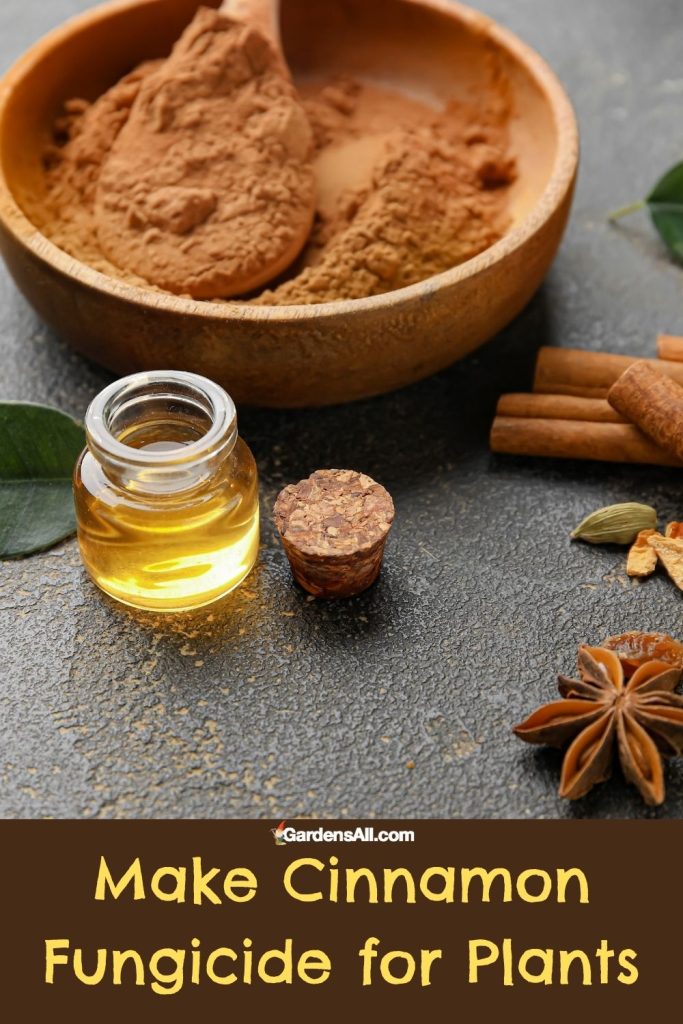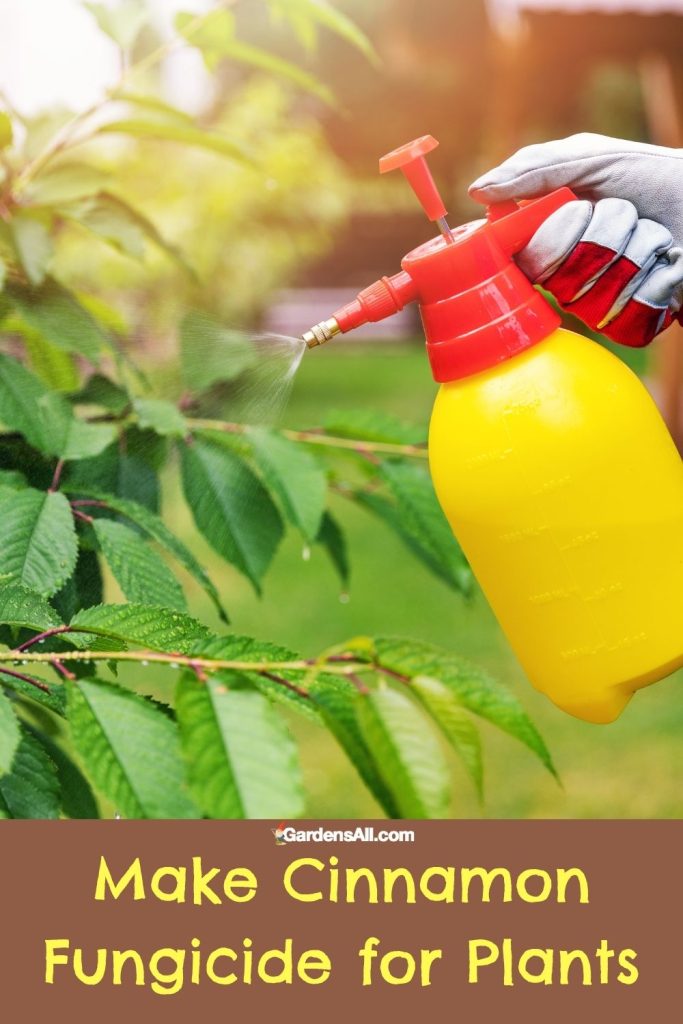If you’re wondering how to make cinnamon fungicide for your plants, and also how often to use it, we cover that in this short article.
But first, a quick summary of the results from a scientific study on fungicidal benefits of cinnamon for plants.[1]https://www.ncbi.nlm.nih.gov/pmc/articles/PMC8433798/
The study highlights the antifungal properties of cinnamon oils and extracts against various plant pathogens. Several research works are cited, which collectively demonstrate the effectiveness of cinnamon in controlling plant diseases caused by fungi.
Proven Benefits of Cinnamon Fungicide
- Cinnamon (Cinnamomum zeylanicum) leaf oil exhibited the strongest antifungal activity against Botrytis cinerea, a serious plant pathogen responsible for gray mold in horticultural crops.
- Cinnamon oils and extracts have shown fungicidal effects against pathogens isolated from bananas, such as Colletotrichum musae, Lasiodiplodia theobromae, and Fusarium proliferatum.
- Cinnamon demonstrated antifungal activity against other fungi like Oidium murrayae, Colletotrichum gloesporioides, Rhizoctonia solani, and Alternaria solani, which are responsible for diseases in various crops.
- Cinnamon microemulsions proved to be effective in controlling gray mold of pears caused by Botrytis cinerea.
- Cinnamon extracts, particularly in combination with clove extracts, showed potential in controlling strawberry gray mold.
- Cinnamon oil exhibited significant inhibitory effects on various Fusarium species, which cause diseases like Fusarium wilt and Fusarium head blight in crops like tomato and wheat, respectively.
- The use of cinnamon essential oil was effective in controlling F. verticillioides, a pathogen responsible for producing mycotoxins in grains.
- Cinnamon oil also showed potential in preventing the growth of fumonisin, a mycotoxin produced by F. verticillioides in maize grain.
- In vitro studies demonstrated the fungicidal activity of cinnamon oil against Fusarium oxysporum and Phytophthora palmivora, causing fruit rot in crops.
- Cinnamon extracts were found effective against other fungi, such as Aspergillus sp. and Sclerotinia sclerotiorum, which can cause various plant diseases.
Overall, the study provides strong evidence for the fungicidal benefits of cinnamon oils and extracts in controlling a wide range of plant fungal diseases. The results suggest that cinnamon could be a potential natural and eco-friendly alternative to synthetic fungicides for plant disease management.[2]https://www.ncbi.nlm.nih.gov/pmc/articles/PMC8433798/

How to Make Cinnamon Fungicide for Your Garden Plants:
Cinnamon, with its natural antifungal properties, can be used to create an effective and organic fungicide for your garden plants. This homemade fungicide can help protect your plants from various fungal diseases. Here’s a simple recipe to make your own cinnamon fungicide:
Ingredients:
- Ground cinnamon or cinnamon essential oil
- Water
- Spray bottle
Steps:
POWDER: How to Make Cinnamon Powder Fungicide:
- Mix Solution:
- In a container, mix 1-2 tablespoons of ground cinnamon with 4 cups of water. Stir or shake well to ensure the cinnamon is well distributed.
- Let the mixture sit for a few hours or overnight. This allows the active compounds in cinnamon to infuse into the water.
- Strain:
- After the mixture has infused, strain it through a fine sieve or cheesecloth to remove any solid particles. (Optional, but may help to keep your sprayer free of any clogging residue.
- Pour into Spray Bottle:
- Transfer the strained liquid into a clean spray bottle. Make sure to label the bottle to indicate that it contains cinnamon fungicide.
OIL: How to Make Cinnamon Essential Oil Fungicide:
- Dilute the Oil:
- Mix 5-10 drops of cinnamon essential oil with 1 liter of water. Essential oils are highly concentrated, so this dilution will ensure it’s safe for your plants.
- Mix Thoroughly:
- Shake the mixture well to ensure the essential oil is evenly dispersed in the water.
- Pour into Spray Bottle:
- Transfer the diluted mixture into a clean spray bottle. Label the bottle accordingly.
Application:
- Before applying the fungicide, it’s recommended to test it on a small part of a plant to ensure that there’s no adverse reaction.
- On a dry, calm day, spray the fungicide evenly onto the leaves and stems of your plants, making sure to cover both sides of the leaves.
- Apply the fungicide every 1-2 weeks or after rain to maintain its effectiveness.
Note:
- While cinnamon is generally safe for plants, some sensitive plants might still react negatively to it. So discontinue use if you notice any negative impact.
- For severe fungal infections, consult with a gardening expert or consider using other organic treatments in addition to the cinnamon fungicide.
Making your own cinnamon fungicide can be an effective and economical way to protect your garden plants from fungal diseases. Consistency is key, so regularly apply the fungicide as needed to eliminate fungus from your plants and always reapply as needed, following rain.
You can find more on How to Use Cinnamon for Plants here and also How to Use Cinnamon for Ants here.

I’m LeAura Alderson, a garden, herb and plant enthusiast with a passion for discovering the many edible and medicinal benefits of the plants all around us, including the weeds! I’m a writer, editor and media publisher for our family of websites.
While I was certified in fitness and life coaching, I am NOT a health practitioner. However, I’m a lifelong health enthusiast, with a keen interest in healthy, organic foods and making home remedies and the content we share is from our own experience and usage as well as that extracted from scientific research so that you can explore further on your own.
Always seek the advice and guidance of your health practitioners first and foremost.
As a family we’re steadily expanding our gardening, experimentation and knowledge around all things gardening, edible landscaping, fresh organic foods and self sustainability with farming in our future. I also own and manage iCreateDaily.com, a site all about transformation through creation, and the power of positivity, optimism and mindset.
References

